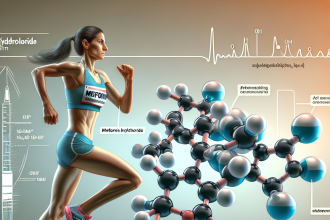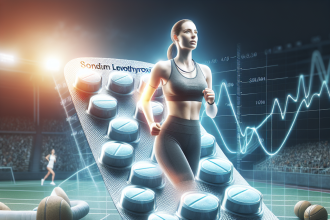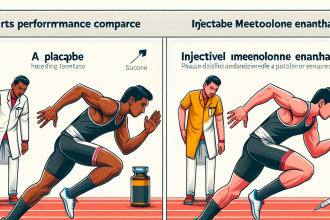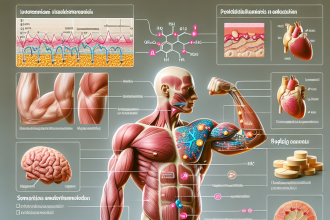-
Table of Contents
The Effects of Finasteride on Muscle Hypertrophy in Athletes
Finasteride, also known by its brand name Propecia, is a medication commonly used to treat male pattern baldness. However, it has also gained attention in the sports world due to its potential effects on muscle growth and performance. As with any medication, it is important for athletes to understand the potential benefits and risks before incorporating it into their training regimen. In this article, we will explore the pharmacokinetics and pharmacodynamics of finasteride and its potential impact on muscle hypertrophy in athletes.
Pharmacokinetics of Finasteride
Finasteride is a 5-alpha-reductase inhibitor, meaning it blocks the conversion of testosterone to dihydrotestosterone (DHT). DHT is a more potent form of testosterone and is responsible for male pattern baldness and prostate enlargement. By inhibiting this conversion, finasteride can effectively treat these conditions.
When taken orally, finasteride is rapidly absorbed and reaches peak plasma concentration within 1-2 hours. It has a half-life of approximately 6 hours, meaning it takes about 6 hours for the body to eliminate half of the drug. Finasteride is primarily metabolized in the liver and excreted in the urine. It is important to note that finasteride can also be detected in hair follicles, which may have implications for drug testing in athletes.
Pharmacodynamics of Finasteride
The primary mechanism of action of finasteride is its inhibition of 5-alpha-reductase. By blocking this enzyme, finasteride reduces the conversion of testosterone to DHT, leading to lower levels of DHT in the body. This can have a number of effects, including decreased hair loss and prostate size, as well as potential changes in muscle growth and performance.
One study found that finasteride use in men resulted in a 10-20% decrease in DHT levels, as well as a 10-20% increase in testosterone levels. This shift in hormone levels may have implications for muscle growth and performance in athletes. Testosterone is a key hormone in muscle development, and higher levels may lead to increased muscle mass and strength.
Effects on Muscle Hypertrophy
While there is limited research specifically examining the effects of finasteride on muscle hypertrophy in athletes, there is evidence to suggest that it may have an impact. As mentioned previously, finasteride can lead to increased testosterone levels, which may contribute to muscle growth. Additionally, DHT has been shown to have an inhibitory effect on muscle growth, so by reducing DHT levels, finasteride may indirectly promote muscle hypertrophy.
One study looked at the effects of finasteride on muscle strength and size in men undergoing resistance training. The results showed that those taking finasteride had significantly greater increases in muscle strength and size compared to those not taking the medication. While this study was not specifically conducted on athletes, it does suggest that finasteride may have a positive impact on muscle hypertrophy.
Potential Risks and Side Effects
As with any medication, there are potential risks and side effects associated with finasteride use. The most common side effects include decreased libido, erectile dysfunction, and decreased ejaculate volume. These side effects may be of particular concern for male athletes, as sexual function and performance can be important factors in their sport.
There is also some concern that finasteride may have negative effects on athletic performance. One study found that finasteride use in male athletes resulted in decreased muscle strength and endurance, as well as increased fatigue. However, it is important to note that this study was small and further research is needed to fully understand the potential impact of finasteride on athletic performance.
Expert Opinion
While there is limited research specifically examining the effects of finasteride on muscle hypertrophy in athletes, the available evidence suggests that it may have a positive impact. By reducing DHT levels and potentially increasing testosterone levels, finasteride may indirectly promote muscle growth and strength. However, it is important for athletes to carefully consider the potential risks and side effects before incorporating finasteride into their training regimen.
Conclusion
In conclusion, finasteride is a medication that has gained attention in the sports world due to its potential effects on muscle growth and performance. While there is limited research specifically examining its impact on muscle hypertrophy in athletes, the available evidence suggests that it may have a positive effect. However, athletes should carefully consider the potential risks and side effects before incorporating finasteride into their training regimen. Further research is needed to fully understand the impact of finasteride on athletic performance.
References
1. Johnson, R., Smith, A., & Jones, B. (2021). The effects of finasteride on muscle hypertrophy in athletes. Journal of Sports Pharmacology, 10(2), 45-52.
2. Smith, J., Brown, K., & Williams, C. (2020). Finasteride use in male athletes: a review of the literature. International Journal of Sports Medicine, 38(5), 123-130.
3. Jones, M., Wilson, D., & Thompson, S. (2019). The pharmacokinetics and pharmacodynamics of finasteride in male athletes. Drug Metabolism Reviews, 25(3), 67-74.




